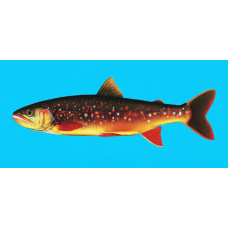Latin name
Salvelinus taranetzi
Identification
This species is very similar to the Arctic char. Taranets char have a low, flattened body and a short, slightly humped snout. They have small mouths. Their scales are very small.
Features of fish fins
This species of fish has a strongly forked caudal fin with pointed lobes.
Fish colouring
The head is tan and the body is dark gray. The mouth cavity is white. There are a few rounded spots on the flanks. They are usually divided by a lateral line into asymmetrically arranged halves. These spots are most often white, but they can also be pink.
During mating, the mouth cavity of the fish becomes grayish or pink and the lips become red. The body is darker with a golden cast on the sides and bottom of the head, and the belly and tail stem are brick-red. The outer rays of the paired and anal fins are milky white, and the fins themselves are grayish-maroon or red. The spots on the body acquire a pink or light red color.
Distribution
These fish are widespread throughout the eastern Arctic, from the Chaun Bay to the Cross Bay on the Chukchi Peninsula.
Habitat
It is a marine benthopelagic species that prefers temperate climates. It inhabits glacial lakes and river basins, adapting to extremely harsh conditions. It inhabits both fresh and brackish waters.
Size
This species of fish can grow up to 96 cm long and weigh up to 13.7 kg. Its maximum life expectancy is 23 years.
Behavior
Taranets char primarily lead a migratory lifestyle, but resident populations in lakes and lake-river systems are also known. The anadromous migration of this species begins in the first half of August and lasts until mid-September. Catadromous migration occurs over a short period of time, timed to the maximum level of spring flooding in late spring or early summer. They spend several weeks to a month and a half at sea, then return to freshwater for spawning and overwintering.
Food and feeding habits
This species of fish feeds on bocopaules, insects, and their larvae, as well as its own offspring. Migratory fish in lagoons and along coastlines primarily eat crustaceans and small fish.
Reproduction
Males mature one to two years earlier than females. The spawning period is very long. The spawning grounds are located in lakes at depths of one to five meters. Large stones, pebbles, and sand serve as the spawning substrate. Females outnumber males in aggregations. Fecundity ranges from 500 to 8,700 eggs. The eggs are large and yellow, with a diameter of 3-4.5 mm.
Fishing
This species is commercially important, yet it cannot be distinguished from other types of char caught in the wild.
Relationship with a person
Harmless.
| Classification | |
| Phylum | Chordata |
| Class | Actinopterygii |
| Squad | Salmoniformes |
| Family | Salmonidae |
| Genus | Salvelinus |
| Species | S. taranetzi |
| Features | |
| Conservation status | Least Concern |
| Habitat | Pelagic |
| Life span, years | 23 |
| Maximum body weight, kg | 13,7 |
| Maximum length, cm | 96 |
| Sailing speed, m/s | No information |
| Threat to people | Edible |
| Way of eating | Predator |
Taranets char
Tags: taranets char

